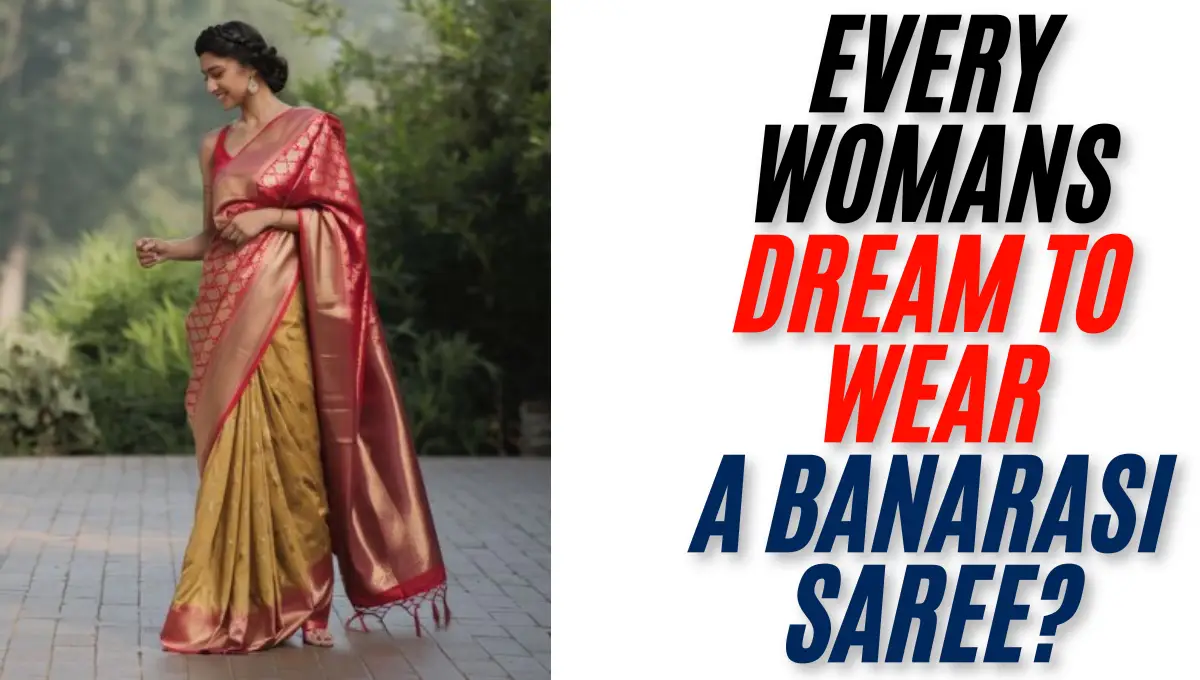It is a woman’s dream to wear a Banarasi saree, a cherished tradition deeply rooted in Indian culture and heritage. Known for their intricate brocade work and luxurious silk fabric, these exquisite sarees are the epitome of elegance and grace.
Every Womans dream to wear a Banarasi saree at least once, be it a wedding, a festive occasion, or a cultural celebration. Banarasi sarees have a rich history dating back to the Mughal era, making them a timeless piece of art.
Handwoven by skilled artisans, they feature delicate motifs inspired by nature, such as flowers and leaves, reflecting the artistry of India. Owning and wearing a Banarasi saree is not just about fashion; it is about embracing tradition, heritage, and craftsmanship.
Banarasi Saree: Every Woman’s Dream:
Banarasi sarees are a testament to India’s rich heritage and craftsmanship. Known for their luxurious texture, intricate designs, and cultural significance, these sarees are every woman’s dream attire, especially for weddings, festivals, and special occasions.
Amira Fashion Store has a wide range of Banarasi sarees for women that reflect the essence of Indian traditions and modern elegance. Check out our curated list of stunning Banarasi sarees for 2025 that will make every bride and women shine on her special day.
Types of Banarasi Sarees
- Pure Silk (Katan)
- Made of pure silk threads, offering a smooth finish and rich look.
- Known for elegant motifs and minimalistic designs.
- Organza (Kora) with Zari Work
- Sheer fabric adorned with intricate zari patterns.
- Lightweight and perfect for formal events.
- Shattir
- A modern variant, ideal for contemporary Banarasi sarees.
- Lightweight and easy to drape.
- Georgette Banarasi
- Made from fine georgette fabric, featuring subtle designs.
- Popular for party wear and casual occasions.
- Brocade Banarasi
- Highlighted with heavy zari work, showcasing Mughal-inspired patterns.
- Favored for bridal wear.
- Jangla
- Features intricate floral and jangla (wild) patterns woven with zari.
- Rich and opulent, perfect for grand occasions.
- Tanchoi
- Famous for its colorful silk patterns without zari.
- Lightweight and showcases fine weaving.
- Cutwork Banarasi
- Made with cutwork technique on plain texture.
- Features floral and leaf motifs, ideal for semi-formal wear.
- Tissue Banarasi
- Woven with golden zari, creating a metallic sheen.
- A favorite among brides for its luxurious appeal.
How to Care for Banarasi Sarees?
- Cleaning:
- Avoid washing at home. Dry clean only to maintain texture and zari shine.
- Storage:
- Store in a muslin cloth to allow airflow and prevent zari tarnishing.
- Avoid plastic covers to prevent moisture retention.
- Folding:
- Fold the saree inside out to protect the zari work.
- Refold periodically to avoid permanent creases.
- Avoid Direct Sunlight:
- Do not expose to direct sunlight for long periods to prevent fading.
- Ironing:
- Use a low-heat setting. Prefer steam ironing on the reverse side.
- Pest Protection:
- Place neem leaves or silica gel packets to keep away insects.
- Airing:
- Air the saree periodically in shade to prevent odor and ensure longevity.
Why Banarasi Sarees are Special?
- Rich Heritage: Originates from Varanasi, with designs inspired by Mughal art.
- Exquisite Craftsmanship: Handwoven with intricate detailing.
- Symbol of Elegance: A must-have for weddings and festive occasions.
- Timeless Appeal: Passed down through generations, symbolizing tradition and luxury.
Womans Dream to Wear a Banarasi Saree?
The Banarasi saree is not just a garment; Every womans dream to wear a Banarasi saree stems from its unmatched beauty, cultural significance, and timeless elegance.
These sarees are more than just attire; they are a symbol of heritage, tradition, and regal sophistication that every woman aspires to embrace.
1. A Legacy of Craftsmanship
Banarasi sarees hail from Varanasi (Banaras), one of the oldest cities in the world. They are handwoven with intricate patterns, using fine silk threads and zari (gold or silver threads), making each saree a work of art.
Owning one is like possessing a piece of history, lovingly crafted by artisans who have mastered their trade over generations.
2. A Symbol of Grace and Elegance
Draping a Banarasi saree transforms a woman into a vision of poise and sophistication. Its rich fabric, intricate designs, and luxurious sheen exude a regal aura, making it the perfect attire for weddings, festivals, and special occasions.
3. A Heritage Staple for Weddings
No Indian wedding is complete without the splendor of a Banarasi saree. Brides often choose it as their wedding attire, blending traditional roots with timeless beauty.
The saree’s magnificence symbolizes prosperity, cultural pride, and blessings for a prosperous future.
4. Versatility and Variety
Banarasi sarees come in various styles, such as Jangla, Tanchoi, Shattir, and Cutwork, each with unique weaving techniques and motifs. From floral patterns to Mughal-inspired designs, they offer endless options to suit different tastes and occasions.
5. Timeless Appeal
Unlike fleeting fashion trends, the Banarasi saree is a classic that never goes out of style. It is often passed down as a family heirloom, carrying memories, emotions, and cultural significance from one generation to the next.
6. A Blend of Tradition and Modernity
Today, designers are reinventing Banarasi sarees with contemporary elements, making them versatile for modern women. Paired with trendy blouses or styled in innovative ways, the saree continues to resonate with women of all ages.
7. Empowering Artisans
Choosing a Banarasi saree is not just about wearing a beautiful outfit; it is also about supporting the skilled weavers of Varanasi. Every purchase sustains their art, ensuring the preservation of this glorious tradition.
Conclusion
The dream of wearing a Banarasi saree goes beyond its aesthetic appeal. It is a celebration of heritage, an ode to Indian craftsmanship, and a token of timeless elegance.
For every woman, draping a Banarasi saree is like embracing a piece of history and embodying the grace that it represents. It’s not just a saree; it’s an emotion, a legacy, and a dream woven in silk and gold.

